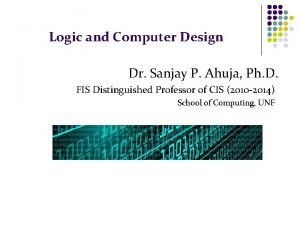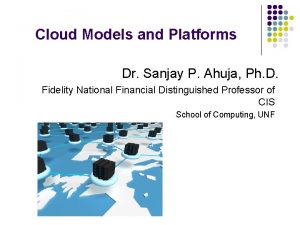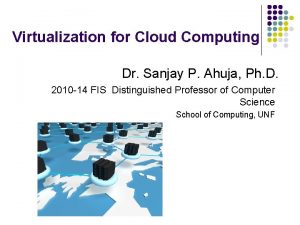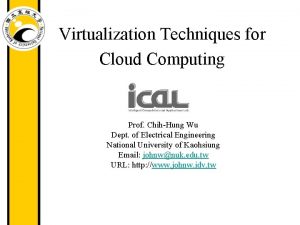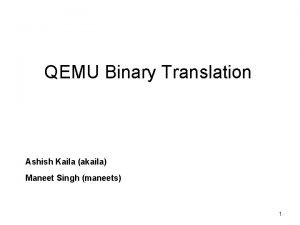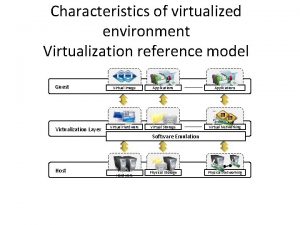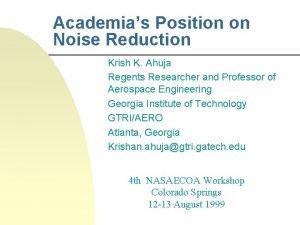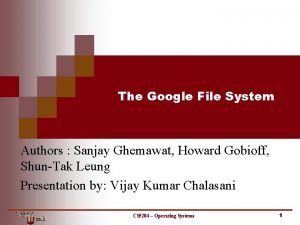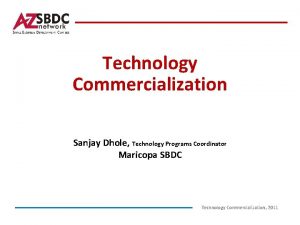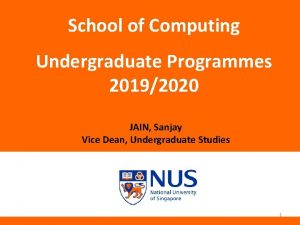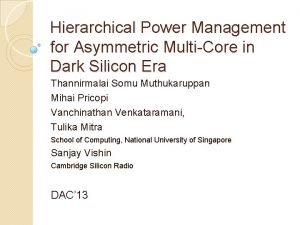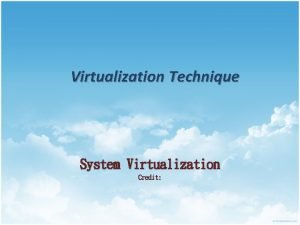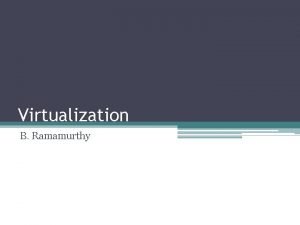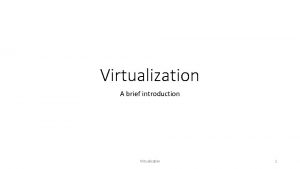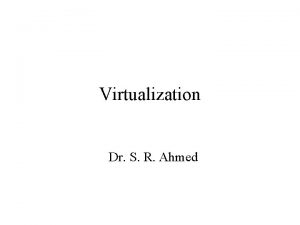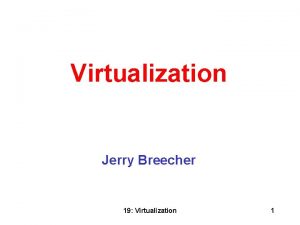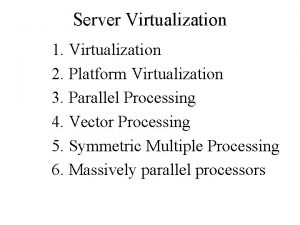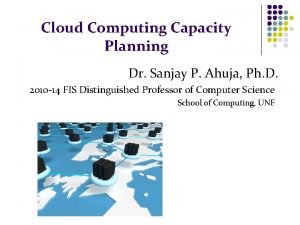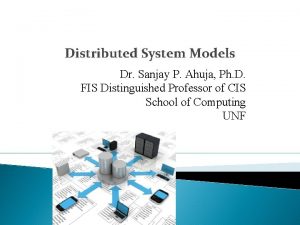Full and Para Virtualization Dr Sanjay P Ahuja

















- Slides: 17

Full and Para Virtualization Dr. Sanjay P. Ahuja, Ph. D. Fidelity National Financial Distinguished Professor of CIS School of Computing, UNF

x 86 Hardware Virtualization l The x 86 architecture offers four levels of privilege known as Ring 0, 1, 2 and 3 to operating systems and applications to manage access to the computer hardware. While user level applications typically run in Ring 3, the operating system needs to have direct access to the memory and hardware and must execute its privileged instructions in Ring 0. x 86 privilege level architecture without virtualization

Technique 1: Full Virtualization using Binary Translation l This approach relies on binary translation to trap (into the VMM) and to virtualize certain sensitive and non-virtualizable instructions with new sequences of instructions that have the intended effect on the virtual hardware. Meanwhile, user level code is directly executed on the processor for high performance virtualization. Binary translation approach to x 86 virtualization

Full Virtualization using Binary Translation l This combination of binary translation and direct execution provides Full Virtualization as the guest OS is completely decoupled from the underlying hardware by the virtualization layer. l The guest OS is not aware it is being virtualized and requires no modification. l The hypervisor translates all operating system instructions at run-time on the fly and caches the results for future use, while user level instructions run unmodified at native speed. l VMware’s virtualization products such as VMWare ESXi and Microsoft Virtual Server are examples of full virtualization.

Full Virtualization using Binary Translation l The performance of full virtualization may not be ideal because it involves binary translation at run-time which is time consuming and can incur a large performance overhead. l The full virtualization of I/O – intensive applications can be a challenge. l Binary translation employs a code cache to store translated hot instructions to improve performance, but it increases the cost of memory usage. l The performance of full virtualization on the x 86 architecture is typically 80% to 97% that of the host machine.

Technique 2: OS Assisted Virtualization or Paravirtualization (PV) l Paravirtualization refers to communication between the guest OS and the hypervisor to improve performance and efficiency. l Paravirtualization involves modifying the OS kernel to replace nonvirtualizable instructions with hypercalls that communicate directly with the virtualization layer hypervisor. l The hypervisor also provides hypercall interfaces for other critical kernel operations such as memory management, interrupt handling and time keeping. Paravirtualization approach to x 86 Virtualization

Technique 3: Hardware Assisted Virtualization (HVM) l Intel’s Virtualization Technology (VT-x) (e. g. Intel Xeon) and AMD’s AMD-V both target privileged instructions with a new CPU execution mode feature that allows the VMM to run in a new root mode below ring 0, also referred to as Ring 0 P (for privileged root mode) while the Guest OS runs in Ring 0 D (for de-privileged non-root mode). l Privileged and sensitive calls are set to automatically trap to the hypervisor and handled by hardware, removing the need for either binary translation or para-virtualization. l Vmware only takes advantage of these first generation hardware features in limited cases such as for 64 -bit guest support on Intel processors.

Summary Comparison of the Current State of x 86 Virtualization Techniques

Full Virtualization vs. Paravirtualization l Paravirtualization is different from full virtualization, where the unmodified OS does not know it is virtualized and sensitive OS calls are trapped using binary translation at run time. In paravirtualization, these instructions are handled at compile time when the non-virtualizable OS instructions are replaced with hypercalls. l The advantage of paravirtualization is lower virtualization overhead, but the performance advantage of paravirtualization over full virtualization can vary greatly depending on the workload. Most user space workloads gain very little, and near native performance is not achieved for all workloads. l As paravirtualization cannot support unmodified operating systems (e. g. Windows 2000/XP), its compatibility and portability is poor.

Full Virtualization vs. Paravirtualization l Paravirtualization can also introduce significant support and maintainability issues in production environments as it requires deep OS kernel modifications. The invasive kernel modifications tightly couple the guest OS to the hypervisor with data structure dependencies, preventing the modified guest OS from running on other hypervisors or native hardware. l The open source Xen project is an example of paravirtualization that virtualizes the processor and memory using a modified Linux kernel and virtualizes the I/O using custom guest OS device drivers.

Memory Virtualization l This involves sharing the physical system memory and dynamically allocating it to virtual machines. VM memory virtualization is very similar to the virtual memory support provided by modern operating systems. l The operating system keeps mappings of virtual page numbers to physical page numbers stored in page tables. All modern x 86 CPUs include a memory management unit (MMU) and a translation lookaside buffer (TLB) to optimize virtual memory performance. l To run multiple virtual machines on a single system, another level of memory virtualization is required. In other words, one has to virtualize the MMU to support the guest OS.

Memory Virtualization l l l The guest OS continues to control the mapping of virtual addresses to the guest memory physical addresses, but the guest OS cannot have direct access to the actual machine memory. The VMM is responsible for mapping guest physical memory to the actual machine memory, and it uses shadow page tables to accelerate the mappings. The VMM uses TLB hardware to map the virtual memory directly to the machine memory to avoid the two levels of translation on every access.

I/O Virtualization l I/O Virtualization involves managing the routing of I/O requests between virtual devices and the shared physical hardware. l The hypervisor virtualizes the physical hardware and presents each virtual machine with a standardized set of virtual devices. l These virtual devices effectively emulate well-known hardware (with device drivers) and translate the virtual machine requests to the system hardware. l This standardization on consistent device drivers also helps with virtual machine standardization and portability across platforms as all virtual machines are configured to run on the same virtual hardware regardless of the actual physical hardware in the system.

I/O Virtualization in Xen: Indirect driver model l Xen uses an indirect driver design that routes virtual machine I/O through device drivers in the Windows or Linux management operating systems. l Xen uses an indirect split driver model consisting of a front-end driver running in Domain U (user VMs) and the backend driver running in Domain 0. These two drivers interact with each other via a block of shared memory. l The front-end driver manages the I/O requests of the guest OS and the backend driver is responsible for managing the real I/O devices and multiplexing the I/O data of different VMs. These generic (standard) backend drivers installed in Linux or Windows OS can be overtaxed by the activity of multiple virtual machines and are not optimized for multiple VM workloads. l There is also CPU overhead associated with this approach because I/O is proxied via Domain 0.

I/O Virtualization in VMWare ESXi: Direct driver model l ESXi uses a direct driver model that locates the device drivers that link virtual machines to physical devices directly in the ESXi hypervisor. l With the drivers in the hypervisor, VMware ESXi uses optimized and hardened device drivers and provides special treatment, in the form of CPU scheduling and memory resources, that they need to process I/O loads from multiple virtual machines.

Scalability of VMWare and Xen driver models l VMware direct driver model scales better than the indirect driver model in Xen. l As shown in the chart below, Xen, which uses the indirect driver model, shows a severe I/O bottleneck with just three concurrent virtual machines, while VMware ESX continues to scale I/O throughput as virtual machines are added.

Reference l l Overview of x 86 Server Virtualization Technology http: //www. cubrid. org/blog/dev-platform/x 86 -server-virtualization-technology/
 Dr sanjay ahuja
Dr sanjay ahuja Sanjay ahuja amazon
Sanjay ahuja amazon Dr sanjay ahuja
Dr sanjay ahuja Sanjay ahuja md
Sanjay ahuja md Virtualization techniques in cloud computing
Virtualization techniques in cloud computing Binary translation in virtualization
Binary translation in virtualization Disadvantages of virtualization
Disadvantages of virtualization Virtualization structures/tools and mechanisms ppt
Virtualization structures/tools and mechanisms ppt Shaman ahuja
Shaman ahuja Sumiti ahuja
Sumiti ahuja Krish ahuja
Krish ahuja Bhoomika ahuja
Bhoomika ahuja Sanjay ghemawat
Sanjay ghemawat Sanjay ghemawat
Sanjay ghemawat Sanjay dhole
Sanjay dhole Myedu nus
Myedu nus Dr sanjay dubey indore
Dr sanjay dubey indore Sanjay vishin
Sanjay vishin
